Our Galakrond Shaman deck list guide goes through the ins-and-outs of this midrange deck in Descent of Dragons meta! This guide will teach you how to mulligan, pilot, and substitute cards for this archetype!
Introduction to Galakrond Shaman
The Dragons descended into Hearthstone, bringing with them, arguably, the most powerful of them all; Galakrond, the Tempest, Shaman’s version of the new Hero Card, which took the ladder by storm, prompting Blizzard to issue the quickest balance changes in the history of the game, just 10 days after the expansion’s release. Although the balance changes did slow the deck down quite a bit, it remains a really strong choice to climb the ranks before the new year.
There are two versions of the deck, with the other one using Corrupt the Waters, Shaman’s Quest, to gain the Hero Power Heart of Vir'naal, in order to use it before playing Galakrond, the Tempest, summoning 4 8/8s with Rush, instead of 2. Although that is a good list, in its own right, the Quest-less version, which we cover in this guide, can be a little more aggressive in the early game, allowing it to pressure opponents faster and compete with face decks.
Key Cards
- Mutate: Mutate is, once again, a key tempo card in a Shaman deck, mainly because of Mogu Fleshshaper, even after his nerf, in the latest patch. The card allows you to get a favorable trade, then transform the minion into a random one, of 1 mana cost higher, which will, at least, heal the minion back to its stats, on average.
- Earth Shock: The inclusion of Earth Shock in the list comes, mainly, as an answer to Deathrattle Rogue, which is quickly gaining popularity, since it allows you to slow the deck down just enough, for you to snowball any early-to-midgame lead into a victory, although it certainly helps against aggressive decks as well.
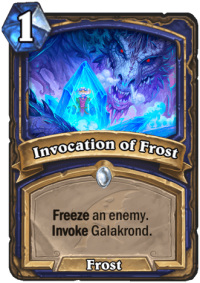
- Invocation of Frost: Maybe the best early game card in the game, this 1-cost spell is a Glacial Shard on steroids, allowing you to freeze an enemy, while gaining a 2/1 rush minion on the board. It is extremely powerful in the early game, so much so, that you can justify casting it on turn 1, against classes that can’t remove it with hero power.
- Dragon's Pack: Remember the “4 mana 7/7” meme? Ah, those were the days. Well, this is that meme, only stronger and with no Overload downside. The only requirement is you have to have Invoked Galakrond, the Tempest twice, which is a pretty tame one, to be honest. Summoning 10/12 worth of stats, for 5 mana, across 2 bodies is ridiculous enough, but the fact that they have Taunt just adds salt to the wound, since the opponent will have to go through them, in order to fight for board control.
- Faceless Corruptor: Although the card got nerfed, just days ago (which shows you the power it already had), it is still a really good tempo 5-drop, especially in a deck that often floods the board, so it can take advantage of the Battlecry. Trading favorably with a minion, then transforming it into a 4/4 for another trade can really push your lead on the board, especially against other aggressive or tempo decks.
- Corrupt Elementalist: The best Invoke card in the game and the only one that does it twice. Since the Invoke mechanic happens twice, you also gain 2 2/1 Rush minions to establish board control, which is pretty ridiculous, especially when you consider it used to be at 5 mana.
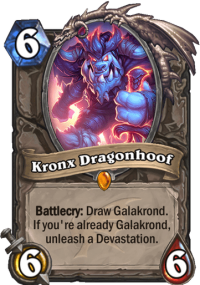
- Kronx Dragonhoof: A really interesting card, this Legendary minion, that is essential to any Galakrond deck. If you don’t have your class’s Galakrond card in hand, this 6/6 for 6 mana draws it from your deck, just in time for you to play him on the following turn. But, and here’s the kicker, if you have already played Galakrond, this minion’s Battlecry allows you to choose from 4 different and powerful effects, designed to help you in (almost) any scenario: Annihilation deals 5 damage to all other minions, helping you clear the board, Decimation deals 5 damage to the enemy hero, restoring the same amount to yours, Domination gives +2/+2 to your other minions and Reanimation summons an 8/8 Dragon with Taunt.
- Galakrond, the Tempest: The most important card of the deck, around which it is built. This is a Hero Card, used as a finisher, that transforms your hero, changing your Hero Power to Galakrond's Fury and giving you 5 armor, along with a powerful Battlecry. In Shaman’s case, the Battlecry is summon 2 2/2s with Rush (0-1 Invokes), summon 2 4/4s with Rush (2-3 Invokes) or summon 2 8/8s with Rush and equip a 5/2 weapon (4+ Invokes).
- Mogu Fleshshaper: A minion of interest, during the Tombs of the Past event that happened this fall, this card finally got nerfed, although it’s not an absolute one. Even though it is a 3/4 Rush for 9 mana, the mana cost goes down by 1 for each minion on the board, regardless of side. This allows you to flood the board, or take advantage of an enemy that is doing that, to summon him, trade favorably, then cast Mutate to transform him into a 10-cost minion (!), with the pool of available 10-cost minions being small and really good. Although the card takes a lot more to come down early, after the nerf, the chance for a 10-cost minion in the mid-game is more than enough to compensate and justify keeping it in the list.
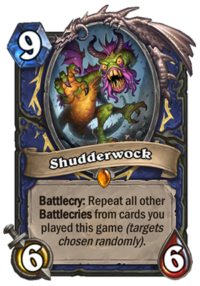
- Shudderwock: An old familiar face makes his return to the spotlight, just before he is moved to wild. Shudderwock takes advantage of the deck’s high number of Battlecries, replicating them. That means that the Invokes to Galakrond, the Tempest are replicated, summoning 2/1 Rush minions and making copies of himself (through Faceless Corruptor‘s Battlecry). Although Shudderwock is not the deck’s main finisher, it can be used as a powerful tempo and value card, which can, often enough, win you games on its own.
Mulligan
Against aggressive decks: Invocation of Frost, Sludge Slurper, Mind Control Tech, Mogu Fleshshaper + Mutate
Against slow decks: Far Sight, Mana Tide Totem, Kronx Dragonhoof/Galakrond, the Tempest, Shudderwock
Main Goal and Strategy
The deck revolves around using the new Invoke mechanic as a tempo tool for board control, while drawing cards to get to Galakrond, the Tempest, which the deck uses as a finisher. 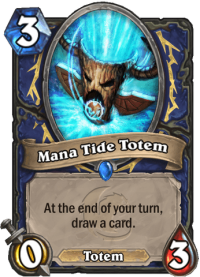
Your early game is usually aggressive, spent using cards like Invocation of Frost and Sludge Slurper to gain board control, which will allow you to gain more value from your Mana Tide Totem, digging for your Invoke cards and your 2 finishers (Galakrond, the Tempest and Shudderwock). Also, keep in mind that using Far Sight to draw in the early game can prove extremely rewarding, as the majority of the deck is mid-to-late-game focused.
The mid-game is where the deck starts to really turn up the heat, as it uses the Invoke mechanic as a tempo tool to push the opponent off the board with the Rushing 2/1s. Once you have Invoked at least twice, which is not difficult to achieve by turn 5, Dragon's Pack can be a really strong play against most of the decks on ladder, since the 6 health points that the summoned taunts have, make it a real pain for your opponent to deal with. If you are facing an aggressive or face deck, this spell can be your opponent’s bane, forcing them to spend the next couple of turns getting through them, giving you time to pressure him and finishing him off, before he can deal enough damage to do the same.
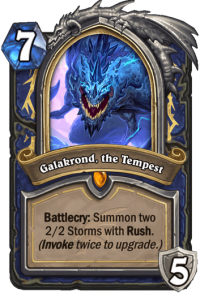
Going into the late-game, your objective is just one; play Galakrond, the Tempest (hopefully after you have Invoked 4 times, so you can gain the full value of the card), which usually puts the opponent on a clock, since he will have to deal with 2 8/8 bodies and you will be able to deal extra damage with your 5/2 weapon. Shudderwock can act as a pseudo-finisher, if you have trouble finding Galakrond, the Tempest (or Kronx Dragonhoof to draw him), or a secondary Galakrond, the Tempest, as it replicates the card’s battlecry, summoning the 2 8/8s with Rush and giving you a new 5/2 weapon to use.
Although the deck lacks any direct healing, remember that you can use Kronx Dragonhoof‘s Decimation effect (Deal 5 damage to the enemy hero. Restore 5 Health you hero.) to get out of lethal range and buy a little more time.
Possible Replacements
Although the deck contains a pretty high number of synergistic cards, that cannot be replaced, without losing those synergies, one notable change that could be made to the deck is replacing the package of Mogu Fleshshaper + Mutate for Witch's Brew and Walking Fountain, if you find yourself facing a lot of aggressive decks on your climb, or you expect aggressive lineups in a tournament.

Mogu Fleshshaper + Mutate does not give you a 10 mana minion. Mutate and the other evolve stuff now consider the minion’s cost to be its cost at the time of playing it. I believe it’s the same if you summon it either.
Nope. It gives you a 10 mana minion
Honestly I prefere the version without the nerfed cards (2 silence, heal and so on)
Don’t you just love it that this deck runs every single card that just got nerfed?
Well the nerfs were very subtle and are almost negligible. This deck went from tier 0 to tier 1
Are you going to do this for all the Galakrond cards?